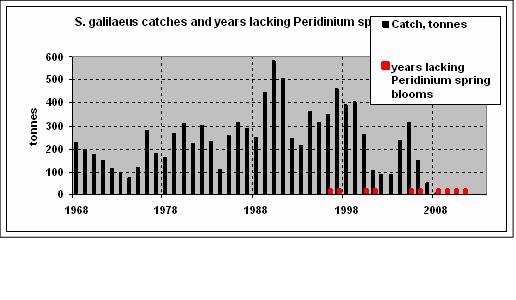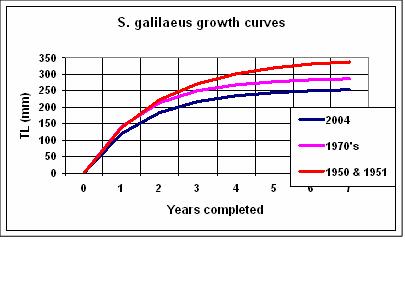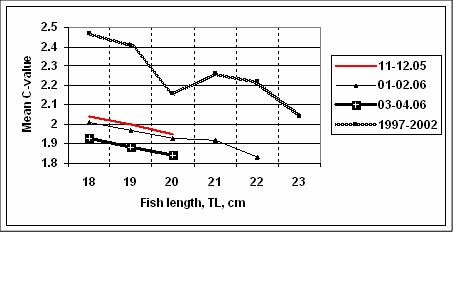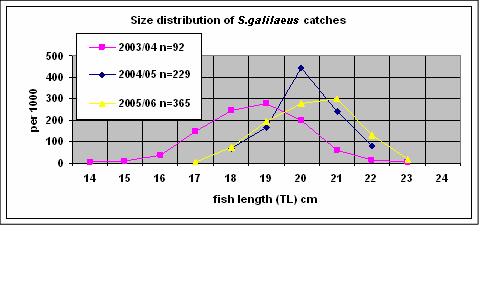Tilapia of L. Kinneret – a damaged treasure
The cichlid Sarotherodon galilaeus of Lake Kinneret is also known as Tilapia, St. Peter’s fish and musht. The Hebrew name, amnun hagalil (mother fish of Galilee) refers to the ‘mothering’ of the young in the mouth of both male and female fish. Noted for its fine flavor and for historical connections, Kinneret Tilapia is one of the treasures of the lake.
 Fig. 1. S. galilaeus catches since 1968 (1) (statistics for years after 2008 not available) and years lacking Peridinium spring blooms (2).
Fig. 1. S. galilaeus catches since 1968 (1) (statistics for years after 2008 not available) and years lacking Peridinium spring blooms (2).
S. galilaeus has been highly exploited since 1968. The annual catch, which reflects stock size to a large extent, has had wide fluctuations. But there has not been a downward trend as severe as in recent years, with yield dropping to 8 tonnes in 2008. Fishery statistics are not available for 2009 to 2012, but from data presented in this blog it can be surmised that the S. galilaeus stock did not recover its former abundance.
From 2004 to 2007, with the generous support of the Israel Dept of Fisheries and the assistance of Mr. Tsvi Snovsky, I was able to sample over 700 S. galilaeus specimens in the Tiberias Laboratory. Mr. Snovsky brought my attention to the dominance of small sized S. galilaeus in previous catches, a symptom of ‘overfishing’, excessive removal of young specimens depriving the stock of potential growth, i.e. a cause of deceasing yield. I challenged this concept by a growth study.
Decreasing growth potential
The scales of S. galilaeus have clearly marked annual rings, so that it is possible to determine year-class and also to back-calculate growth increments from measurements of radii on fish scales. From 2004 data a final length, L-infinity, of 25 cm was estimated. In contrast, L-inf of the S. galilaeus population in the 1970’s was estimated at 28 cm and in the 1950’s at 35 cm (Fig 2).
 Fig.2. S. galilaeus growth curves estimated from length-at-age data (6,16) and back-calculated values (16). Differences between growth curves are statistically significant.
Fig.2. S. galilaeus growth curves estimated from length-at-age data (6,16) and back-calculated values (16). Differences between growth curves are statistically significant.
Fish that are genetically inclined to fast growth are vulnerable to fish nets at a younger age than slow-growers; therefore they are selectively removed by exploitation. When a stock diminishes, as the S. galilaeus stock did in recent years, the shift to slow-growers intensifies. This is called ‘dwarfing’ or ‘stunting’. If the bulk of the stock falls below the desired minimum size, 20 cm total length (TL), fishermen adjust mesh size of nets to capture smaller fish. They are not ‘overfishing’, i.e. removing fish at too young an age for maximum sustained yield. On the average, a 20 cm (~200 g) fish taken in the 1950’s would be the same age as a 16 cm (~80 g) fish taken in 2004.
Because it is a short-lived species with early maturity, Tilapia is not vulnerable to over-exploitation at too young an age. In contrast, sturgeon may reach a marketable size of at least 1 meter length and ~7 kg weight long before reaching maturity at 14 – 18 years (up to 30 kg). Targeting immature sturgeon is true overfishing; it results in depletion of the stock and loss of caviar.
But the S. galilaeus stock is vulnerable to ‘dwarfing’: dominance of slow-growing fish due to high exploitation. To maintain profitability, ‘dwarfing’ could be mitigated by reducing the number of fishing units operating in years of low abundance. The next sections of this blog show how abundance changes can be predicted at least a year in advance.
Starving to death
One of the causes of diminishing S. galilaeus stock size in recent years, probably the main cause, is starvation. All the samples taken 2004 to 2006 were underweight (Table 1) especially the spring 2006 samples; the drop in C values between Jan/Feb 2006 and Mar/Apr 2006 is statistically highly significant (Fig.3). Visceral fat, which in earlier years increased in winter and spring, was absent in 2006 samples.
Table 1. Condition factor, C, of S. galilaeus (C= g/mm3 x 105 )
|
N |
Mean C-value |
Period |
|
242 |
2.20 |
1974 – 19771 |
|
201 |
24.2 |
1997 – 20022 |
|
664 |
1.98 |
2004 – 2006 |
S.D. of C-values = 0.01 – 0.02
1Landau (1979) 2Snovsky and Shapiro, Israel Dept of Fisheries, personal communication.
The S.D. values indicate statistically highly significant differences between recent and former data. Changes within the 2005/06 season are also significant. In the Dayg v’Midgeh paper (22) S.D. = 0.1 – 0.2 was printed by mistake, mine, not the editor’s.
 Fig. 3 . Mean condition factors, C, of S. galilaeus taken 1997 – 2002 (Snovsky & Shapiro, unpublished data) compared to C-values in the 2005/06 fishing season.
Fig. 3 . Mean condition factors, C, of S. galilaeus taken 1997 – 2002 (Snovsky & Shapiro, unpublished data) compared to C-values in the 2005/06 fishing season.
Table 2. Age-classes (per 1000) in S. galilaeus catches
|
Catch, T*** |
Age 5 |
Age 4 |
Age 3 |
Age 2** |
Fishing season* |
|
163 |
5 |
51 |
212 |
734 |
2003/04
|
|
377 |
6 |
0 |
47 |
946 |
2004/05
|
|
156 |
3 |
24 |
598 |
376 |
2005/06 |
*November – April. ***November – October
**Year-class 2002 in the 2003/04 fishing season, Y-2003 in 2004/05 and Y-2004 in 2005/06.
From the ratios of numbers in succeeding year-classes, mortality was estimated at 88 % per year. Part of this mortality must have been due to starvation. Poor fish condition is also connected to eye disease which reached epidemic proportions in Tilapia in 2011 while it had a lesser impact on other Kinneret fish.
Importance of Peridinium
It has long been known that the main food organism for S. galilaeus in L. Kinneret is the dinoflagellate alga Peridinium gatunense. In years of ecological stability, most fish growth occurred in spring, during and shortly after the Peridinium bloom season. Till late summer the fish fed upon dead Peridinium on the lake bottom. October to November was a period of low food intake, growth cessation, loss of visceral fat reserves, and decline in fish condition (30, 16).
In contrast, samples taken during October and November, 2004, showed a growth increment of 15 mm. In the 1990’s amounts of Peridinium in both summer and fall increased (2). This may account for the better-than-average S. galilaeus yields of 1998 and 1999 despite lack of Peridinium spring blooms in 1996 and 1997. Also, there were high water levels in this period which boost Tilapia survival in its first season.
Since the year 2000 Peridinium spring bloom is the dominant but not the sole factor in Tilapia yield. In the 2003/04 season (November to April), catches consisted largely of fish that had hatched in 2002 during or following a Peridinium spring bloom. The previous year-classes, Y-2001 and Y-2000 were weak – both hatched in no-bloom years. In the following two fishing seasons, the stock was strengthened by Y-2003, produced in a year of Peridinium spring bloom. The low catches of 2007 and 2008 followed no-bloom springs in 2005 and 2006.
 Fig.4. Size distribution of random samples of S. galilaeus trammel-net and purse-seine catches, November to April, 2003 to 2006.
Fig.4. Size distribution of random samples of S. galilaeus trammel-net and purse-seine catches, November to April, 2003 to 2006.
Normally, S. galileaus fish condition improves in spring, the Peridinium bloom season. In the no-bloom spring of 2006, fish condition dropped exceptionally low (Fig.3). These were adult fish taken in the breeding season, so their poor condition implies impaired ability as ‘mothers’ i.e. mouth breeders, and explains the weakness of broods hatched in Peridinium no-bloom years.
From the failure of Peridinium spring blooms four years in succession, 2008 to 2011, continued failure of the Kinneret Tilapia fishery can be surmised. The Peridinium spring bloom in 2012 suggests possibility of improvement after 2014.
Changes in the seasonal abundance of Peridinium are a result of lower water levels, as described in the main section of the blog “lakekinneret”. Water level affects the Tilapia stock in other ways as well.
Low water level shrinks littoral
In the 1970’s, observing gut content of S. galilaeus young-of-the-year collected on the littoral (shallow inshore area), I found zooplankton and benthos in the summer but only detritus, algal material and sand in fingerlings captured October and November (16). This indicates critical conditions for Tilapia on the littoral in autumn. The cup-shaped inner contours of the lake imply a narrow littoral plunging down to the lower layer (hypolimnium), which is anoxic in summer and autumn.
As water level descends in the summer months, area of the littoral decreases and oxygen is depleted. Minimum water level is reached in November or December (rarely in January). From 1969 to the mid-1980’s water level had no influence on catch, but when the water level fell below -212 MSL, the minimal values showed a statistically significant correlation to S. galilaeus yield 2 years later (Fig.5, Table 3). This suggests stress in the early life stages of the fish due to shrinking of the littoral and low oxygen concentration.
 Fig. 5. Minimal water levels of L. Kinneret, November to December, 1969 – 2012 (based on Water Authority data), and years lacking Peridinium spring blooms (2).
Fig. 5. Minimal water levels of L. Kinneret, November to December, 1969 – 2012 (based on Water Authority data), and years lacking Peridinium spring blooms (2).
Table 3. Correlation coefficients R2 between minimal water levels and S. galilaeus catches taken two years later.
|
|
Number of pairs |
Co-efficient R2 |
Period |
|
Not significant |
37 |
0.278 |
1969 – 2008 |
|
Significant, 5% level |
21 |
0.519 |
1985 – 2008 |
Stress-induced epidemic of eye disease
Since 2011 there have been reports of an eye disease causing blindness in Kinneret fish, most especially in S. galilaeus. Fish are more susceptible to disease when they are under stress; the dominant factors are low oxygen concentration, poor nutrition, overcrowding, organic matter in the water and other pollutants.
The S. galilaeus stock has been under stress of relatively low oxygen concentration since1999, and of especially low oxygen in May 2012 (2). In addition, the failure of Peridinium spring blooms four years in succession, 2008 to 2011, left the stock in poor condition.
Stocking program fails to replenish Tilapia
In the period 1968-1991, pond-bred S. galilaeus fingerlings introduced to L. Kinneret numbered between ~0.5 million to ~3.5 million per year (1). The stocking program made a small but statistically significant contribution to catch in these years: ~2.6 tonnes/million fingerlings (19). After 1991, when stocking rates were as high as 6 million per year, there was no rise in yield attributable to stocked fingerlings.
In past years fat reserves and/or late introduction enabled stocked fingerlings to survive low summer-fall food supply. Since 1991, stocking is no longer advantageous due to higher Peridinium abundance in summer-fall. Besides, failure of Peridinium spring blooms would subject stocked fingerlings to the same adverse conditions as lake-bred fingerlings. Therefore the stocking program cannot replenish Tilapia under present conditions.
Management overrides science
In a 2007 telephone conversation the director of Israel Dept of Fisheries announced “We have begun again to collect length/weight data of amnun hagalil. There was a gap in this data between 2004 and 2006”. What! I spluttered, “Between 2004 and 2006 I collected such data with the help of your laboratory!” He answered “Nachon, aval zeh lo rashmit” (Yes, but not officially). Please note – there was no allusion to inaccuracies of the data, they are just ‘unofficial’.
I was not invited to the March 2008 sadna (workshop) organized by water and fishery managers to discuss the failure of the Tilapia fishery (37). By consensus, 31 ‘experts’ (moomhim) decided that the main causes were ‘overfishing’ (excessive removal of young specimens depriving the stock of potential growth), and insufficient enforcement of regulations to prevent ‘overfishing’.
Among the ten other factors given consideration, the sole reference to low water levels was in regard to its limiting effect on area for growth of young fish. The connection of water level to Peridinium spring blooms and oxygen concentration, both relevant to Tilapia, was not mentioned. Only one participant voted for Peridinium abundance as a factor.
‘Dwarfing’ was mentioned only as a theoretical possibility. No one presented the evidence, available to participants, which showed that ‘dwarfing’ accounts for the dominance of small specimens in Tilapia catches rather than ‘overfishing’.
On fish condition nothing whatsoever is reported; neither the ‘unofficial’ data collected 2004 to 2006, nor the ‘official’ data collected since 2007. Starvation is not included among factors of S. galilaeus stock size.
Obviously, this sadna was not a scientific meeting; it had a political purpose. Both water and fisheries managers tried to deflect attention away from the linkage of low water levels to poor water quality and failing fisheries of L. Kinneret.
The Dept. of Fisheries published results of my 2004 -2007 study of S. galilaeus in the same issue of their journal “Dayg v’Midgeh” as the report on the sadna (22, 37). Preceding my article is the comment: “The data were drawn from the author’s knowledge and personal information”. This comment absolves Dept of Fisheries employees from complicity in producing politically incorrect results (my acknowledgement of help from Messrs Snovsky and Shapiro was removed).
In fishery management, politics has priority over scientific findings and scientific ethics. Politics, however, cannot determine the condition of the S. galilaeus stock; it is governed by the laws of nature. If revival of the fishery had priority, then scientific work – pursuing knowledge of natural phenomena within an ethical framework – would be encouraged, not penalized.
Summary
The S. galilaeus fishery of L. Kinneret, previously yielding 200 – 500 tonnes in most years, collapsed in 2008. High fish mortality is associated with low water levels through failure of Peridinium spring blooms, reduced littoral and low oxygen concentration. A stress-induced epidemic of eye disease caused further mortality.
The predominance of small fish in recent catches is not due to ‘over-fishing’. Exploitation selectively removed fast-growers from the stock resulting in a downward shift in population growth rate, i.e. ‘dwarfing’.
Stock abundance changes can be predicted at least one year ahead., Reduction in number of fishing units operating in years of low abundance would mitigate ‘dwarfing’ and help maintain profitability.
Reduced pumping of Kinneret water has raised hope for the eventual rehabilitation of the lake. Some degree of recovery of the S. galilaeus fishery can be expected after the year 2014.
